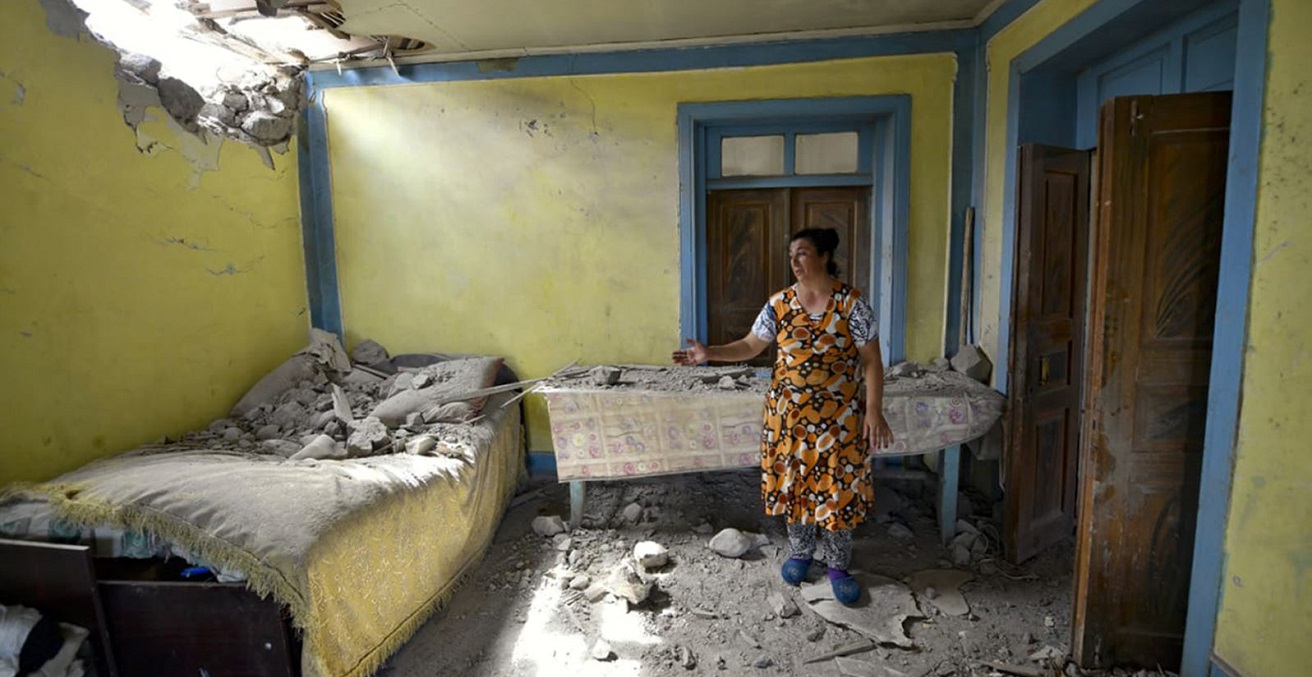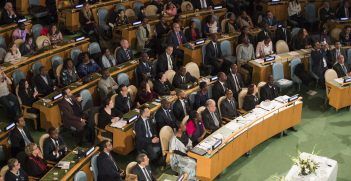History Returns to the South Caucasus

The conflict between Armenia and Azerbaijan over the territory of Nagorno-Karabakh was frozen for over two decades. The involvement of Turkey has upended the balance maintained by Russia throughout this period, and the ensuing great-power entanglements have complicated efforts at a definitive resolution.
Nagorno-Karabakh is a territory that few outside a small community of Caucasus experts would have given much attention to until a few weeks ago. One of the de-facto statelets that emerged from the ethnic convulsions that accompanied the collapse of the USSR, the conflict that lay at its origins between Armenia and Azerbaijan was considered “frozen.”’ Its resolution was outsourced to the Organization for Security and Co-operation in Europe’s (OSCE) “Minsk Group” of states, chaired by France, the United States, and of course, the South Caucasus’ former imperial power, Russia.
Yet, since 1994, the year a Russian-brokered cease-fire froze the first Karabakh war, any moves towards a final resolution have remained elusive. This should not come as a surprise, as the conflict surrounding the unrecognised Armenian-inhabited republic is of complex nature that can only be understood from multiple levels of analysis.
Keeping the Balance
To start with, unlike in Abkhazia and South Ossetia, Russia’s influence on and position within the conflict was always indirect and ambiguous. Rather than taking a clear side, it had maintained good relations with both Armenia and Azerbaijan, allying itself to the former and establishing a “strategic partnership” with the latter. The oil-fuelled shifts in the balance of power towards Azerbaijan were compensated for by Russia’s military alliance with Yerevan, complemented by forceful diplomacy between the two sides in times of crisis. While this did not provide a definitive resolution – something arguably not entirely in the Kremlin’s interest – this balancing act kept the extreme animosity of the two societies in check.
While Armenia’s continued insistence on complete self-determination, and Azerbaijan’s on the restoration of its territorial integrity, precluded a definitive solution, topography and the advantage of defence also made any attempts by Azerbaijan to challenge the status-quo exceedingly costly. The two adversaries engaged in larger-scale skirmishes in 2016 and July 2018 – likely occasional reminders by Baku that it had not accepted the status-quo – but otherwise, there was very little practical movement towards either compromise or war. The unchallenged nature of the OSCE Minsk Group format ensured the continued authority of its co-chairs’ consensus on continuing negotiations.
Observers had expressed hope that the 2018 “Velvet Revolution” in Armenia would inject some dynamism into the Minsk process. In fact, the coming to power of a new cohort of politicians, including the first leader in a generation not to hail from the disputed territory, was seen as a positive sign. But his election merely underscored the limited extent to which leaders on both sides can go against the consensus in both their societies on the territory’s status as an indispensable part of their identity. Arguably, contrary to simplistic readings of “democratic peace theory,” the relative liberalisation of Armenia complicated matters as it added a political element to the gulf between the two states. Azerbaijan’s autocratic nature makes it even less possible than before to integrate Nagorno-Karabakh – where people have grown used to a measure of political freedom – into the country.
A Balance Disrupted
This growing gulf was made worse by increasingly uncompromising signalling in both capitals and a military setback in July, when skirmishes on the border with Armenia led to the death of an Azerbaijani general and protests erupted demanding military action in Baku. Turkey’s newfound willingness and ability to engage in high-stakes interventions after 2015 helped push an Azerbaijani leadership already frustrated by the deadlock in the negotiations into a strong pivot towards Ankara, putting an end to Russia’s decades-old attempts to maintain the conflict’s frozen nature as the holder of a balance between the two belligerents.
Indeed, Ankara was a more-than-eager participant in this venture. Since about 2015, it had departed from the “zero-problems” policy of the previous decade based on cautious, positive engagement with its neighbourhood. Declining domestic support for the ruling AKP, ideological shifts, and the fraying of the “liberal international order” had produced a willingness to belligerently engage in regional theatres where less US engagement had left a vacuum. With Russia doing the same in Syria and Libya, the South Caucasus has apparently come to be seen as one way for Ankara to create linkages by penetrating Russia’s own “back yard,” pressuring an ally of Moscow’s, and putting it on the spot regarding a strategic partner “with options” – Azerbaijan.
In previous years, combined pressures from Washington and Moscow would have precluded Turkey from disturbing the balance upheld for so long by Russia, but pressure from Washington has so far been merely verbal. While France has been vocal in its criticisms of Ankara – not surprising considering the two sides’ multiple confrontations in other theatres – it lacks the local wherewithal to affect the situation on the ground in any way. Russia, on the other hand, has been hesitant in formulating a response – in all probability because of the sudden collapse of a strategy that had served it well for decades.
But to count Russia out would be a mistake. Azerbaijan’s move is, no doubt, risky. It is based on the assumption that Russia, aware of Armenia’s complete dependence on its good graces, would not want to lose Baku – which now has a “Turkish” alternative – by moving against it. But this calculus only goes so far. Russia is also sensitive to foreign political and military intrusions into its “sphere of special interest,” and countenancing a long-term and substantial military presence by any outside power – let alone a NATO member – would be a remarkable, and unlikely shift in its strategic posture.
Moscow also has red lines that, if crossed, would trigger a more determined intervention. They lie along the Armenian-Azerbaijani border by gist of its formal alliance commitments, but possibly also penetrate into Nagorno-Karabakh, where an outright Azerbaijani military victory may not be tolerated. Perhaps tellingly, Russian media have started emitting signals that point to greater concern at the presence of Turkish military personnel and Turkish-supplied Syrian mercenaries in the conflict zone.
One possibility would be for Turkey to withdraw from the region as soon as Baku feels it has “won,” or has attained sufficient gains to strengthen its hand at the negotiating table, with further interventions kept “in reserve.” Another possibility is that Moscow and Ankara may haggle on the sidelines of the Minsk Group, which still remains the default negotiating format in unaltered form. Neither of these options would be a reassuring prospect. A complete military victory by Baku would most probably result in the ethnic cleansing of Armenians from the territory, Moscow may not accept an on-and-off Turkish presence in the future, and judging by the Syrian record, any compromises to emerge from “haggling” – if at all possible considering the sides’ multiple entanglements – would likely remain half-measures.
Combined with the growing distance between the two direct belligerents – both in their political positions and their mutual dehumanisation – these great-power complications make a proxy war involving further escalation, attrition, and crimes against humanity increasingly possible. With a conflict that, in the early 1990s, was seen as a temporary hangover of a previous age roaring back to life, the South Caucasus may thus become yet another place where the end of history has come full circle.
Dr Kevork Oskanian is a Honorary Research Fellow at the University of Birmingham, UK. His current research interests include Eurasian politics and security, postcolonial and civilisational perspectives on Russian narratives of “exceptionalism,” as well as post-liberal approaches to state and International Society in Eurasia and beyond.
This article is published under a Creative Commons Licence and may be republished with attribution.





